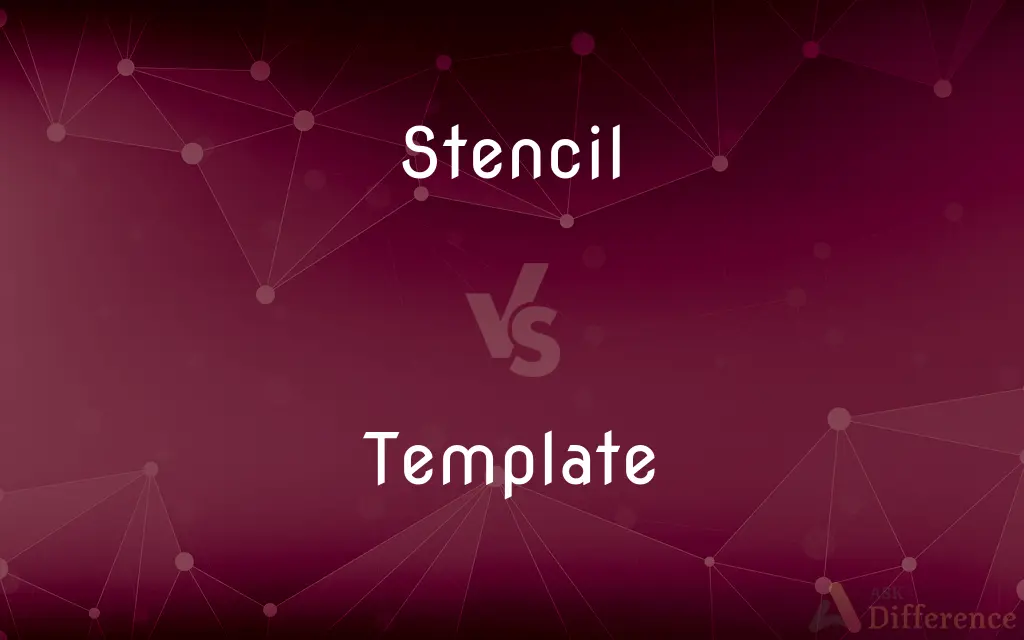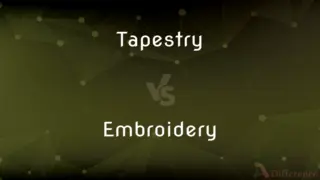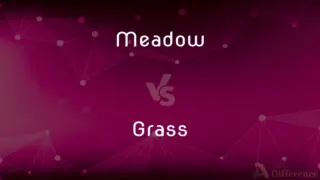Stencil vs. Template — What's the Difference?
By Tayyaba Rehman & Fiza Rafique — Updated on March 19, 2024
A stencil is a sheet with a design cut out, used to apply a pattern or letters by applying ink or paint, while a template is a model or standard for making comparisons or as a basis for design.

Difference Between Stencil and Template
Table of Contents
ADVERTISEMENT
Key Differences
A stencil serves as a tool for reproducing specific shapes, patterns, or letters on various surfaces by applying ink or paint through its cut-out areas. On the other hand, a template acts as a guideline or framework that shapes the structure or layout of a project or document, ensuring consistency and uniformity.
While stencils are commonly used in art, crafts, and industrial design for applying designs onto surfaces, templates are utilized in various fields, including document creation, software development, and architectural planning, to standardize the format and structure of outputs.
Stencils allow for the easy replication of designs by providing a physical guide for where to apply color or materials, facilitating artistic expression and decoration. Templates, however, provide a virtual or physical structure that outlines the essential elements and layout of a project, streamlining the creation process and enhancing efficiency.
The use of stencils is often hands-on and tangible, involving direct interaction with materials and surfaces to transfer designs. Conversely, templates can be both physical and digital, guiding the organization and formatting of information or design elements without direct application to a physical medium.
In summary, stencils focus on the direct application of designs through a cut-out guide, emphasizing artistic and decorative tasks. Templates, meanwhile, serve as overarching frameworks that define the structure and format of projects, contributing to a wide range of applications from document creation to architectural design.
ADVERTISEMENT
Comparison Chart
XDefinition
A tool for applying patterns or designs through cut-out shapes.
A model or guideline for structuring content or projects.
Primary Use
Art, decoration, and design transfer.
Standardizing format and structure in various applications.
Interaction
Direct application of materials (paint, ink) through the cut-out areas.
Guides the organization and formatting of content or design elements.
Materiality
Typically physical, made of materials like plastic, metal, or paper.
Can be both physical (paper, plastic) and digital (software templates).
Application Fields
Art, crafts, interior design, industrial marking.
Document creation, software development, architectural planning, crafting.
Compare with Definitions
Stencil
For applying designs to surfaces.
She used a floral stencil to decorate the walls of her bedroom.
Template
A model for standardization.
The company uses a template for all its official presentations to maintain consistency.
Stencil
Used in art and craft.
Stencils are popular in DIY projects for their ease of use and repeatability.
Template
Guides content layout.
Bloggers often use templates to ensure a consistent look and feel across their posts.
Stencil
Involves cut-out patterns.
The artist crafted a stencil out of cardboard for his graffiti artwork.
Template
Used in digital and physical formats.
Architects use templates to draft floor plans efficiently.
Stencil
Can be reusable or single-use.
The stencil for the mural was designed to be used multiple times across the city.
Template
Can be customized for various needs.
The template for the website allowed for easy customization of colors and fonts.
Stencil
Aids in uniformity of design application.
The bakery used a stencil to apply the logo uniformly on all cakes.
Template
Facilitates efficiency and uniformity.
The newsletter template streamlined the production process for the marketing team.
Stencil
Stencilling produces an image or pattern by applying pigment to a surface under an intermediate object with designed gaps in it which create the pattern or image by only allowing the pigment to reach some parts of the surface. The stencil is both the resulting image or pattern and the intermediate object; the context in which stencil is used makes clear which meaning is intended.
Template
A shaped piece of rigid material used as a pattern for processes such as cutting out, shaping, or drilling.
Stencil
A sheet, as of plastic or cardboard, in which a desired lettering or design has been cut so that ink or paint applied to the sheet will reproduce the pattern on the surface beneath.
Template
A timber or plate used to distribute the weight in a wall or under a support.
Stencil
The lettering or design produced with such a sheet.
Template
A pattern or gauge, such as a thin metal plate with a cut pattern, used as a guide in making something accurately, as in woodworking or the carving of architectural profiles.
Stencil
The process of printing with such a sheet.
Template
A document or file having a preset format, used as a starting point for a particular application so that the format does not have to be recreated each time it is used
A loan amortization template for a spreadsheet program.
Stencil
To mark with a stencil.
Template
An overlay that fits over all or part of a keyboard and has labels describing the functions of each key within a particular application.
Stencil
To produce by stencil.
Template
A horizontal piece of stone or timber used to distribute weight or pressure, as over a door frame.
Stencil
A thin sheet, either perforated or using some other technique, with which a pattern may be produced upon a surface; a utensil that contains a perforated sheet.
Template
(Biochemistry) A molecule of a nucleic acid, such as DNA, that serves as a pattern for the synthesis of a macromolecule, as of RNA.
Stencil
Pattern A pattern produced using such a utensil.
Template
A physical object whose shape is used as a guide to make other objects.
Stencil
A two-ply master sheet for use with a mimeograph.
Template
A generic model or pattern from which other objects are based or derived.
Stencil
To print with a stencil.
Template
(computing) document template file with a basic outline for a work
Stencil
A thin plate of metal, leather, or other material, used in painting, marking, etc. The pattern is cut out of the plate, which is then laid flat on the surface to be marked, and the color brushed over it. Called also stencil plate.
Template
(molecular biology) A macromolecule which provides a pattern for the synthesis of another molecule.
Stencil
To mark, paint, or color in figures with stencils; to form or print by means of a stencil.
Template
A partially defined class or function, that can be instantiated in a variety of ways depending on the instantiation arguments.
Stencil
Device that has a sheet perforated with printing through which ink or paint can pass to create a printed pattern
Template
A strip of metal used in boiler-making, pierced with a series of holes, and serving as a guide in marking out a line of rivet-holes.
Stencil
Mark or print with a stencil
Template
To set up or mark off using a template.
Template
To provide a template or pattern for.
Template
Same as Templet.
Template
A model or standard for making comparisons
Common Curiosities
Can templates be used in digital formats?
Yes, templates are widely used in digital formats, such as in software, website design, and digital document creation.
Are stencils only used in art?
While commonly used in art and crafts, stencils also find applications in industrial design, interior decorating, and even in educational settings.
What is the purpose of a template?
A template serves as a model or guideline to structure and format content or projects, ensuring consistency and efficiency.
Can a stencil be reused?
Many stencils are designed to be reusable, allowing for the repeated application of a design or pattern.
Can stencils create complex designs?
Stencils can range from simple shapes to intricate designs, allowing for complex patterns to be replicated with precision.
What role do templates play in software development?
In software development, templates provide predefined code structures, speeding up the development process and ensuring code consistency.
What is a stencil used for?
A stencil is used for applying patterns, designs, or letters to surfaces by adding color or material through its cut-out areas.
How do stencils differ from templates?
Stencils are physical guides for transferring designs through direct application, while templates are frameworks for organizing and formatting content or structures.
How can a template improve work efficiency?
Templates standardize the format and layout of tasks, reducing the time and effort needed to recreate structures or formats from scratch.
Do templates limit creativity?
While templates provide a structure, they often include customizable elements that allow for personalization and creativity within a defined framework.
How do templates contribute to branding?
Templates ensure that all company materials, like presentations and documents, maintain a consistent look, reinforcing brand identity.
Are there digital stencils?
Digital or virtual stencils exist, especially in design software, allowing users to apply predefined shapes and patterns in digital artworks.
Can stencils be considered a form of template?
In a broad sense, stencils could be considered a form of template for physical design application, although they serve a more specific purpose than general templates.
How do architects use templates?
Architects use templates to streamline the drafting process, utilizing standardized symbols and layouts for efficiency and accuracy.
Is it possible to create custom stencils?
Custom stencils can be created to fit specific design needs, offering a personalized tool for creative projects.
Share Your Discovery

Previous Comparison
Tapestry vs. Embroidery
Next Comparison
Meadow vs. GrassAuthor Spotlight
Written by
Tayyaba RehmanTayyaba Rehman is a distinguished writer, currently serving as a primary contributor to askdifference.com. As a researcher in semantics and etymology, Tayyaba's passion for the complexity of languages and their distinctions has found a perfect home on the platform. Tayyaba delves into the intricacies of language, distinguishing between commonly confused words and phrases, thereby providing clarity for readers worldwide.
Co-written by
Fiza RafiqueFiza Rafique is a skilled content writer at AskDifference.com, where she meticulously refines and enhances written pieces. Drawing from her vast editorial expertise, Fiza ensures clarity, accuracy, and precision in every article. Passionate about language, she continually seeks to elevate the quality of content for readers worldwide.














































